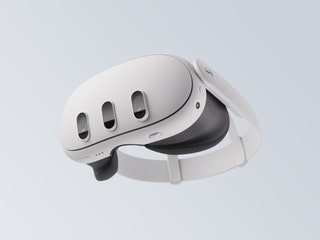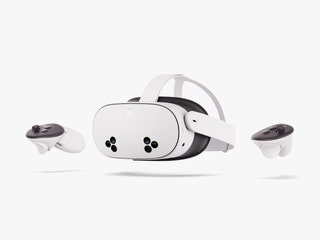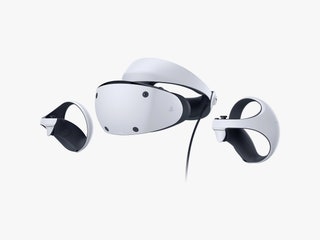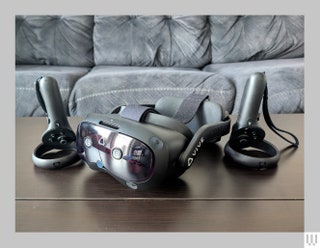The Best VR Headsets
If you buy something using links in our stories, we may earn a commission. Learn more.
Virtual reality has been “right around the corner” for more than a decade. Everyone from indie startups to Apple have made lofty promises about how the future of computing will involve strapping screens to our eyeballs. As it turns out, VR is still primarily best suited for video games, and, occasionally, some highly specialized work. The “metaverse” never happened, but there's still some fun to be had.
Thankfully, there's never been a better time to get into VR. Mixed-reality headsets like the Meta Quest 3S have reached reasonable prices. VR can be a cool way to experience certain games, art experiences, and even sex tech. For those interested, here are the best VR headsets we've tried.
Updated November 2024: We've added the Meta Quest 3S, HTC Vive Focus Vision, and more info about the PS VR 2.
Power up with unlimited access to WIRED. Get best-in-class reporting that's too important to ignore for just $2.50 $1 per month for 1 year. Includes unlimited digital access and exclusive subscriber-only content. Subscribe Today.
Tethered or Wireless VR?
Before I dive deep, there’s one question you need to answer: Do you want a tethered or wireless headset? Tethered VR gives you more graphical detail, because you’re hooked up to a PC. The disadvantage is that you’re, well, hooked up to a PC. There's no getting around the fact that cables are awkward to deal with, especially when you can't see them. You'll likely trip on them at some point. But if you're looking for absolutely top-of-the-line graphics, and you already shelled out for a great gaming PC or laptop, then you'll want to go tethered.
For most people, wireless VR (also called stand-alone VR) is a much better option. It's more comfortable, you don't have to worry about getting tangled up in your own cables, and it's totally portable. You can bring this kind of VR headset to any room in the house without having to lug around a PC. Plus, in the case of the Meta Quest 3, you can plug it into a PC if you want the extra graphical horsepower. Below, I feature both kinds of headsets. Take a look.
Finding Room for VR
VR takes up a lot of space, but where do you set it up? How much room do you need? Headsets like the Meta Quest 3S make it easier to use VR in basically any room of your home (or even sitting on your couch!), but for some games, you might need to move some furniture around.
The key to making space for VR is finding somewhere comfy and familiar like your living room. You'll need plenty of space to stretch out your arms without hitting anything, and preferably room to take a step or two without tripping over furniture. Keep in mind that you can bump into things even if they're not at arm level! One helpful trick to keep you centered is to lay out a yoga mat, so you can tell when you've left the play area.
It's also helpful to consider what types of games or apps you plan to use. Some activities, like watching a movie or trying to accomplish work, can be done in a sitting position on a couch or in a chair. Some headsets will even have different virtual boundaries for standing and sitting positions, to help keep you oriented no matter what you're doing.
Great Games and Apps to Try
Now that you have a headset in mind, all you need are some games to check out. Some of the best VR games are the ones built around short sessions—the kind of game it's easy to pick up and put down since everyone has different tolerances for VR. Some people can play for more than an hour, while others need a break after 15 minutes. Not every game is flexible in that way, but these are. Check out our Best Meta Quest Games and Best PS VR2 Games roundups for more.
- Vader Immortal: This game takes you on a multi-episode adventure in the Star Wars universe as a smuggler captured by the Empire. It's immersive, full of memorable characters, and the environments are absolutely gorgeous. Available on all VR platforms.
- Moss: Moss puts you in the shoes of a kindly forest spirit guiding an adorable mouse knight through her dangerous adventures. Unlike most VR games, this one is designed to be played while stationary, standing, or sitting. Available on all VR platforms.
- Superhot: Stylish, with a pulse-pounding soundtrack, Superhot plays like a cyberpunk action movie. You go from stage to stage, fighting faceless polygon men in slow motion. Time only moves when you move, so you can control the flow of the action and dance out of the way of bullets and projectiles. Available on all VR platforms.
- Beat Saber: There's not much to say about this game. It's Guitar Hero with lightsabers, and I mean that in the best way. Beat Saber is a rhythm game, but instead of pushing buttons to match the notes, you slice them in half with glowing laser swords, and it's one hell of a workout. Available on all VR platforms.
- Half-Life: Alyx: If you're looking for a slower, more story-oriented game, then Half-Life: Alyx is worth a try. And no, it's not Half-Life 3. This game takes place between Half-Life and Half-Life 2, and it puts you in the shoes of Alyx Vance as she tries to keep the alien Combine from acquiring a superweapon. It plays a bit like a survival horror game, with scarce weapons and ammunition, but there are plenty of puzzles to keep things from getting monotonous. Available on desktop-based VR platforms only.
- Horizon Workrooms: It's not as fun as helping a cartoon mouse navigate ancient ruins in a haunted forest, but Horizon Workrooms is a surprisingly pleasant VR workspace. It syncs with your desktop, so you can have your PC screen right there in VR. You can even have a little window through VR and into the real world to see your keyboard and mouse. It can be a fun way to mix things up if you're working from home, and it's a pretty enjoyable workspace if you want to hang out with your coworkers remotely for a while. It's available only on Meta Quest headsets.
VR Headsets to Avoid
VR has been around long enough that some headsets are either obsolete or a little too expensive and cumbersome for what you get. Our picks above will serve most people well, so avoid the following (unless they're steeply discounted).
- Meta Quest Pro: The Quest Pro is an awkward, expensive VR headset, especially in comparison with its cheaper siblings. It's comfier than the Quest 3, as the head straps are easier to manage. However, just because it has “Pro” in the name, doesn't mean it's better. It launched before the Quest 3, and the Snapdragon XR2 Gen 2 in the newer headset has an edge over the Snapdragon XR2+ in the Quest Pro. Both have superior pancake lenses, but the Quest 3 has a higher resolution display with a higher 120-Hz refresh rate. Then again, the Quest Pro features Mini-LED backlighting, so the contrast is nicer. The Pro also supports face and eye tracking, making it better for virtual meeting apps as your avatar can match your facial expressions. Even still, it's hard to recommend it over the Quest 3 at its $1,000 price.
- HTC Vive: One of the original VR headsets, the Vive was good when it came out but doesn't quite measure up to modern offerings like the Quest 2.
- HTC Cosmos Elite: Reviewer Jaina Gray reviewed this headset in 2020. You need to manually set up the base stations, the controllers are bulky and awkward to use, and there are so many cables and dongles (including three power adapters) that it just feels like work. You need to hook it up to your gaming PC, allowing you to play SteamVR games. It's visually spectacular, but the clunky design makes it hard to recommend.
- HTC Vive Flow: The Vive Flow isn't really a VR headset. It's more like a pair of giant, super-thick VR glasses you can slip on to meditate in a virtual space, watch a movie or show, or socialize with friends or colleagues virtually. It's nice for short and casual jaunts into VR. You'll need a 10,000-mAh battery pack and a USB-C cable to power it, but it supports inside-out tracking, so there's no need for any external sensors. It's a few years old at this point, and it wasn't even as powerful as its contemporaries like the Quest 2 or Quest Pro even when it was new. But its design is super lightweight and portable enough to throw into a carry-on and use to watch movies on a flight. That said, the Vive Flow cost $500 when it came out and still costs as much. For that much, you could just as easily pick up a superior Quest 3.
- Oculus Rift & Rift S: The Quest 3S is still a solid budget pick, but you don't need to reach any further back in Meta's product line than that. The Quest 3S does everything these headsets did and way more, and the Quest 3 has even more powerful features.
- Google Daydream: This smartphone-powered VR headset didn't live long. It's now obsolete, like many of Google's projects.









